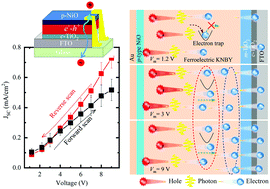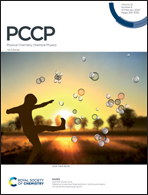Enhanced photovoltaic response of lead-free ferroelectric solar cells based on (K,Bi)(Nb,Yb)O3 films†
Abstract
Herein, we firstly present the (K,Bi)(Nb,Yb)O3 inorganic ferroelectric photovoltaic (FPV) film, in which a nearly ideal bandgap of ∼1.45 eV in the center of the solar spectrum and the co-existence of oxygen vacancies as well as ferroelectric polarization were confirmed. Furthermore, a novel cell structure is successfully fabricated by combining charge-transporting TiO2 nanoparticles, the perovskite sensitizer and a light-absorbing oxide hole p-type NiO conductor to realize a 1 V open circuit voltage, which can be increased to 1.56 V by adjusting the test bias near the coercive voltage. Additionally, under simulated standard AM 1.5G illumination, a fill factor of 86% and a power conversion efficiency of 0.85% are achieved via oxygen vacancy electromigration and polarization switching modulation. It is shown that the obtained power conversion efficiency is one to three orders of magnitude higher than those of pure BiFeO3 and Pb(Zr,Ti)O3. The enhanced PV effects are well elucidated using the transformation from a Schottky-like barrier to Ohmic contacts caused by polarization switching and oxygen vacancies. Building upon the above studies, deep insights into the bandgap tunability and PV effects in ferroelectric films with high oxygen vacancy concentration are provided and will facilitate a new versatile route for exploring high PV performance based on inorganic ferroelectric films.



 Please wait while we load your content...
Please wait while we load your content...